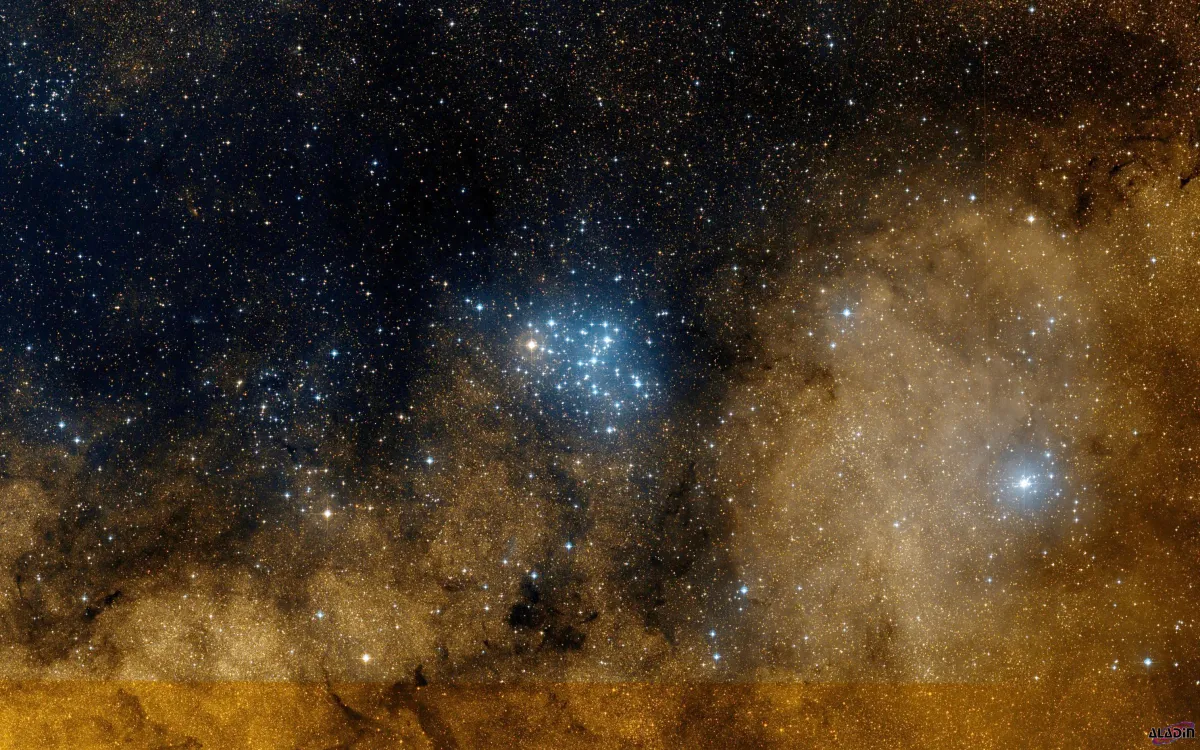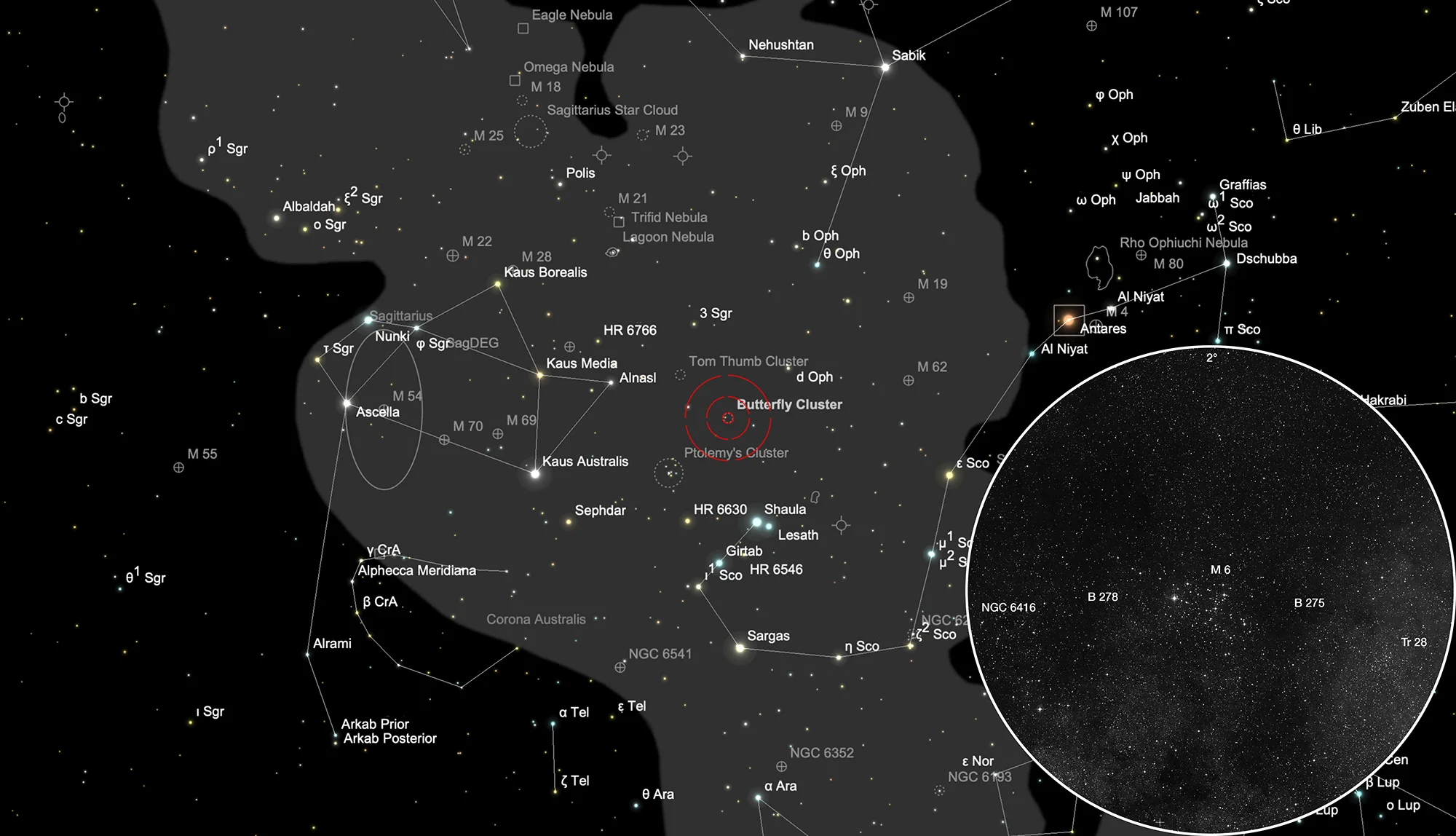Butterfly Cluster (Messier 6)

History
The discovery of Messier 6 is usually credited to P. L. de Cheseaux in 1746, although the globular cluster is visible to the naked eye and already appeared together with M 7 in Ptolemy's catalog. The two appear to be «Girus seine nebulosus» in the 1551 edition of «Amalgest» and were also listed in Ulug Beg's star catalog as the «Stella nebulosa quae sequitur aculeum Scorpionis» (the cloudy ones that follow the scorpion's sting). De Cheseaux, however, was probably the first to recognize a star cluster in M 6. The cluster got its name because of its butterfly-like appearance. The most striking formation are two curved rows of stars, each with about five stars, which are supposed to represent the antennae of the butterfly.
Physical Properties
The visually brightest star in M 6 is BM Scorpii. It is a giant of the spectral class K0-K3. It is semi-regularly variable and varies by about two magnitudes in a cycle of about 850 days. The star is located on the northeast wing tip of the «butterfly» (see fig. 1). Most of the other stars are main sequence B-types. The age of the cluster is estimated to be around 100 million years; older than the Pleiades, but less than half the age of the nearby cluster M 7.
Eighty cluster members were identified within an area of 54 arcminutes. This gives a central star density of around 25 stars per cubic parsec or an average density of 0.6 stars per cubic parsec for the whole cluster (1 pc = 3.26 ly). The figure of the «butterfly» is about nine light years wide, but the entire diameter of the cluster is about 20 light years. Distance measurements vary in a range from about 1300 to 2000 light years, but mostly one finds information in the lower range. [4]
| Name | RA | Dec | Type | bMag | vMag | Dim | MD | Dreyer Description | Identification, Remarks |
|---|---|---|---|---|---|---|---|---|---|
| NGC 6405 | 17 40 20.0 | -32 15 30 | OCL (III2p) | 4.5 | 4.2 | 33 | 0.487 | Cl, L, iR, lC, st 7, 10… | h 3699; GC 4318; M 6; OCL 1030; ESO 455-SC30; Butterfly cluster |
| NGC 6416 | 17 44 19.9 | -32 21 40 | OCL (IV1p) | 5.7 | 15 | 0.741 | Cl, vL, Ri, lC | h 3702; GC 4323; OCL 1031; ESO 455-SC32 |
| Name | Type | RA (J2000.0) | Dec (J2000.0) | PM [mas/y] | Parall. [mas] | Rvel [km/s] | z | Size ['] | Identifiers |
|---|---|---|---|---|---|---|---|---|---|
| Barnard 275 | DNe | 17h 39m 00s | -32° 19' 00" | 13 × 13 | Barnard 275; TGU H2190 P8; [DB2002b] G356.37-0.57 | ||||
| Barnard 278 | DNe | 17h 42m 36s | -32° 18' 00" | 15 × 15 | Barnard 278; [DB2002b] G356.80-1.22 | ||||
| Trumpler 28 | OpC | 17h 36m 55s | -32° 28' 16" | -0.851 | 0.678 | -39.396 | -0.000131 | 5 × 5 | C 1733-324; Cl Trumpler 28; Cl VDBH 238; [KPR2004b] 404; [KPS2012] MWSC 2641 |
Finder Chart
The cluster of butterflies is located directly above the scorpion's tail, which is armed with poisonous stings. On clear summer nights, the open star cluster is also visible to the naked eye. It is best to start with the search in the middle of the star triangle Al Nasl (γ2 Sagittarii) - 45/d Ophiuchi - Shaula (λ Scorpii), as shown on the location map next to it. If a rich, open star cluster appears in the field of view, check the position of the telescope again, because you could have accidentally landed at Messier 7 further south-east. A few other open star clusters are present in the area, but none are as conspicuous as the two Messier clusters.
